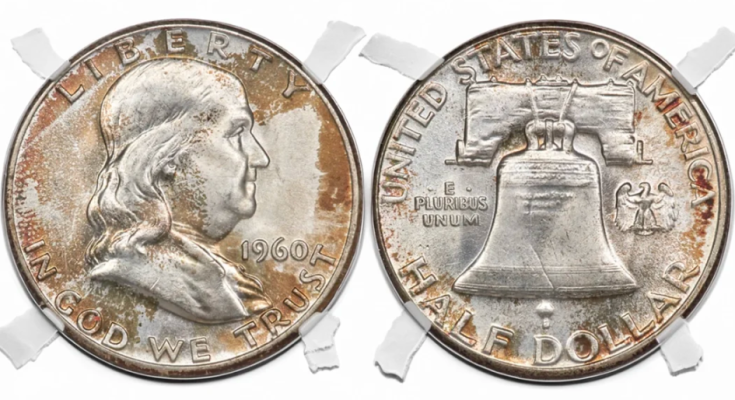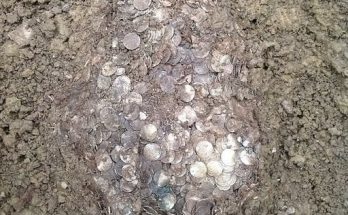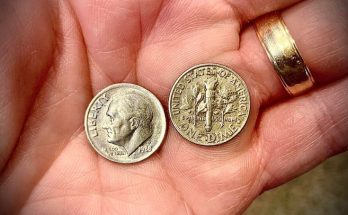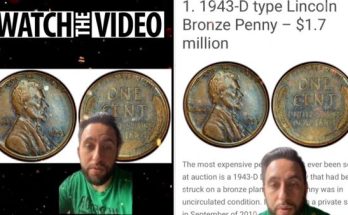The specific design of the Franklin Half Dollar–Founding Father Benjamin Franklin on the obverse and the Liberty Bell on the reverse–was heavily advocated for by pioneering United States Mint Director Nellie Tayloe Ross, who served from 1933 to 1953.
Unfortunately for Ross, the law required the reverse design of the half dollar to include an eagle. But she was so committed to Franklin and the Liberty Bell as two sides of a unitary design that she sidestepped the spirit of the law, which intended that the eagle be the main device, and relegated it to the right-hand field. The Commission of Fine Arts (CFA) advised the Secretary of the Treasury concerning new coin designs and disapproved of the reverse on aesthetic grounds. Nevertheless, Ross pushed forward, stating that the “public must accept it, like it or not.”
The first Franklin Half Dollars came out in 1948. However, because of the large number of Walking Liberty Half Dollars still in circulation due to inflated wartime production, the Mint struck limited numbers of the new Franklin type for the first several years.
Yet by the late 1950s, master dies for the Franklin Half Dollar were extensively worn down. Over a decade of heavy use resulted in extremely soft details on coins, even on brand new “Mint State’ pieces. That changed for the 1960 issuance because the United States Mint finally reworked the master dies. By doing this, the Mint restored detail to the series and banished the comparatively soft and mushy devices of the ’50s.
While the newly reworked master dies re-introduced sharply defined details, especially on the obverse bust of Franklin, the new reverse depiction of the Liberty Bell lacked well-cut lines. Because of this, many otherwise Mint State examples have not earned the coveted Full Bell Lines (FBL) designation. Additionally, many 1960 Philadelphia half dollars display either light grease stains or minor bag marks. As such, it is extremely difficult to find superb Mint State examples.
The 1960 mintages by the Philadelphia (6,024,000 pieces) and Denver (18,215,812 pieces) mints were more than enough to satisfy the nation’s booming economic demands, even after roughly 600,000 half dollars were removed from circulation that year to be melted and recoined.
How Much Is the 1960 Franklin Half Dollar Worth?
The 1960 Franklin Half Dollar is a .900 fine silver coin that no longer circulates for two reasons: first is that half dollars no longer circulate to any great degree, despite their continued issue; and second, the coin’s intrinsic value as of the time of this writing (May 28, 2024) is $11.50. That’s not to say that the typical example is rare. More than six million 1960 Franklin Half Dollars were issued, and although many have been melted down to reclaim their silver bullion, untold hundreds of thousands or more examples survive in conditions ranging from well-worn to Mint State.
The 1960 Franklin Half becomes a conditional rarity only in the grades of MS66+ Full Bull Lines or finer. At the time of writing, only four 1960 Franklin Halves have been graded MS67FBL – two by NGC and two by PCGS. Abrasions and bag marks keep most examples from grading MS65, and strike quality precludes the possibility that the coins might display unbroken Full Bell Lines.
Due to these factors, high-grade FBL examples sell for high dollars. A PCGS-graded MS67FBL piece sold for over $28,000 in a 2016 Heritage auction, and a more recent sale of an NGC MS67BFL nearly hit $8,000. Just two grades down, examples sell for about $120 or $50 without Full Bell Lines.
As the most common grade in the combined NGC and PCGS registries (over 70% of the total population), the price levels off for MS64 examples. These pieces are worth $30 to $40 for the standard grade and up to $60 with the FBL designation.
* * *
Market Data and Noteworthy Specimens
Top Population: PCGS MS67FBL (2, 12/2024), NGC MS67FBL (2, 12/2024), and CAC MS67FBL (1:0 stickered:graded, 12/2024).
- NGC MS67FBL #6277403-008: Heritage Auctions, February 254, 2022, Lot 3074 – $7,800. Angular russet toning on the obverse with peripheral toning of the same color on the reverse. Diagonal hit on truncation. There is a small horizontal mark below the ear and another to the left of the lips. On the reverse, there is a small rim hit above H.
- PCGS MS67FBL CAC #33954768: Heritage Auctions, August 10, 2016, Lot 4146 – $28,200. Ice blue centers with speckled gold and orange toning along the periphery.
- PCGS MS66+FBL #38130037: Stack’s Bowers, June 17, 2024, Lot 1401 – $1,920. Brilliant centers. Light rim toning. Deep rim hit behind Franklins head near lower curls. Copper spot on hair behind ear.
- PCGS MS66+FBL #34590913: Heritage Auctions, March 30, 2018, Lot 3694 – $3,120; GreatCollections, June 19, 2022, Lot 1179562 – View. Dark crescent toning on the obverse and reverse. Myriad tiny ticks on Franklin’s figure and the bell.
- PCGS MS66+FBL CAC #25003964: Legend Rare Coin Auctions, August 27, 2020, Lot 213 – $2,350. Diagonal streaks of aubergine toning with an isolated area of gold, maroon, and aubergine toning in the upper right area of the obverse. Reverse is brilliant.
- PCGS MS66+FBL CAC #36314726: GreatCollections, February 24, 2019, Lot 608069 – View; Legend Rare Coin Auctions, May 16, 2019, Lot 472 – $1,880; Legend Rare Coin Auctions, September 26, 2019, Lot 321 – $2,702.50. Attractive red, green, and blue toning, mostly focused on the left of the obverse.
* * *
Design
It is interesting to note that both the obverse and reverse designs of the Franklin Half Dollar were rejected by the CFA. But it seems that the CFA got it wrong. The Franklin Half Dollar design, despite being simple in concept, has become an icon of modern U.S. coinage, with the coin’s frosted Cameo Proof strikings being highly coveted by collectors.
Obverse:
Mint Chief Engraver John R. Sinnock designed both sides of the Franklin Half Dollar. His obverse design was based on French artist Jean-Antoine Houdon’s 18th-century bust of Franklin. The date 1960 appears in the lower-right of the obverse, while the motto IN GOD WE TRUST curves beneath Franklin and the word LIBERTY curves around the top above Franklin. The designer’s initials JRS are located at the truncation of Franklin’s bust.
Reverse:
Sinnock and future Chief Engraver Gilroy Roberts designed the reverse, which depicts the Liberty Bell and a small eagle (mandated by law) at right.
The legend UNITED STATES OF AMERICA arcs above the Liberty Bell while the denomination HALF DOLLAR curves beneath it. The motto E PLURIBUS UNUM appears to the left of the bell and an eagle, its wings spread, stands to its right. Two sets of three parallel horizontal lines encircle the base and bottom of the bell, a key grading diagnostic indicative of strike quality.
Coins struck at the Denver and San Francisco mints exhibit a small mintmark above the wooden beam holding the Liberty Bell, below STATES in UNITED STATES OF AMERICA. Franklin Half Dollars struck at the Philadelphia Mint do not have a mintmark.
Edge:
The edge of the 1960 Franklin half dollar is reeded.
Designers
From 1925 through 1947, John R. Sinnock was the eighth Chief Engraver of the United States Mint. He is best known for the designs of the Roosevelt Dime and the Franklin Half Dollar.
Gilroy Roberts was the ninth Chief Engraver of the U.S. Mint, serving from 1948-1965. He is best remembered for his design of the Kennedy Half Dollar obverse.
Coin Specifications
| Country: | United States of America |
| Year of Issue: | 1960 |
| Denomination: | Half Dollar (50 Cents USD) |
| Mintmark: | None (Philadelphia) |
| Mintage: | 6,024,000 |
| Alloy: | .900 Silver, .100 Copper |
| Weight: | 12.5 g |
| Diameter: | 30.6 mm |
| Edge: | Reeded |
| OBV Designer: | John R. Sinnock |
| REV Designer: | John R. Sinnock | Gilroy Roberts |
| Quality: | Business Strike |



